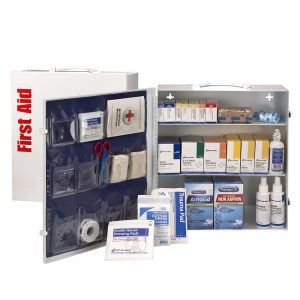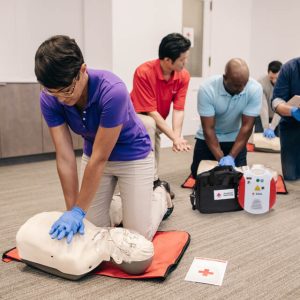First aid kits aren’t missed until they’re needed. If you have a minor injury—a small scrape, cut, or burn—first aid might patch you up just so you can get back to work. But with a serious injury, first aid can have a major impact on the outcome, especially when emergency medical services are not nearby.
A kit that is poorly placed, missing contents, or is missing altogether not only violates OSHA standards, it can signal to employees that the company isn’t valuing their health and safety.
“When companies invest time and money to develop a comprehensive first aid program, they are investing in their most important asset: their people,” says Scott Parkhurst, American Red Cross Instructor and Regional Sales Director at Full Compliance Safety. “At the end of the day, that should be a more important motivation than compliance.”
Nonetheless, first aid kits are a low priority for most businesses, says Parkhurst. In part, this is because OSHA standards can be hard to interpret and enforcement cases are relatively rare. In this article, we will explain what those standards are and what can happen when they’re not met.
Are workplaces required to have first aid kits?
It depends. The Occupational Health and Safety Administration (OSHA) standard on medical services and first aid states:
“In the absence of an infirmary, clinic, or hospital in near proximity to the workplace which is used for the treatment of all injured employees, a person or persons shall be adequately trained to render first aid. Adequate first aid supplies shall be readily available.” –29 CFR 1910.151(b) Occupational Safety and Health Standards: Medical and First Aid
OSHA interprets “near proximity” differently for low and high-risk workplaces. For white-collar workers and workplaces such as offices, where serious injuries are rare, OSHA deems an EMS response time of 15 minutes or less as sufficient. On the other hand, for blue-collar workers and workplaces such as construction sites, manufacturing plants, or warehouses, where serious accidents involving “falls, suffocation, electrocution, or amputation” are possible, the standard is 3-4 minutes.
Solely relying on outside emergency responders, however, is not as simple as searching for the closest fire station or hospital on Google Maps. Rather, OSHA expects employers to take proactive steps, such as making an arrangement with a local service provider. In many cases, first aid training and supplies will be the least complicated, if not only option.
For serious injuries and illnesses, OSHA does not intend first aid to replace professional medical intervention altogether. Rather, first aid is intended to help stabilize the injured person until EMS arrives.
How many first aid kits do you need?
It largely depends on the size and layout of the workspace and the number of employees. OSHA interprets “readily available” to mean that the trained first aid provider can reach both the kit and the injured employee in a “timely manner”. While OSHA does not provide a minimum response time or kit-to-employee ratio, it does say:
“The first aid supplies should be located in an easily accessible area, and the first aid provider generally should not have to travel through several doorways, hallways and/or stairways to access first aid supplies”
What supplies are required in a first aid kit?
Once again, OSHA is intentionally vague regarding the contents of first aid kits. “First aid” in itself is an umbrella term: it has to be adapted to specific work environments and activities while treating a wide variety of injuries and medical conditions. “First aid” can also refer to CPR, AEDs, eye wash stations, and bleed control kits, all of which involve additional training and equipment.
OSHA highly recommends employers to consult a local fire and rescue team, medical professional, or first-aid supplier to adapt their first aid program to the specific needs of the workplace. The California Division of OSHA makes this consultation mandatory.
Historically, OSHA also refers employers to the American National Standards Institute’s (ANSI) “Minimum Requirements for Workplace First-aid Kits.” Even though OSHA emphasizes that these requirements are not mandatory, ANSI/ISEA Z308.1 has become the de facto minimum standard for low and high-risk industries across the U.S..
ANSI/ISEA Z308.1 – “Minimum Requirements for Workplace First-aid Kits”
ANSI has published this standard since 1978, updating it around every five years. The non-profit organization establishes voluntary consensus standards for products and services across many industries, so it relies on trade groups to develop the standards, which it then approves.
For first aid kits, ANSI consults the International Safety Equipment Association, whose core membership consists of manufacturers of personal protective equipment and other work safety supplies.
ISEA’s latest update to first aid kit contents was approved by ANSI on April 15, 2022 and goes into effect on October 15, 2022.
First Aid Kit Classes and Container Types
First aid kits are divided into two categories for low and high-risk workplaces. Class A Kits are designed to deal with most common types of workplace injuries. Class B Kits are for more complex environments, where serious accidents are more likely.
Class A kits have items for treating injuries: bandages, sterile pads, trauma pads, antiseptics, burn treatment, eye/skin wash, and scissors. They also include items to protect the first aid provider: a CPR breathing barrier, medical exam gloves, and hand sanitizer.
Class B kits have more items (i.e. 25 vs 10 burn ointments) and larger items (i.e. a 4 inch x 4 yard roller bandage in addition to 2 in x 4yd). They also add a tourniquet and splint.
Additionally, the storage containers for first aid kits are organized into four types based on work environment:
Type I: Mountable. For indoor settings.
Type II: Portable. For indoor settings.
Type III: Portable, mountable and water-resistant. For indoor or outdoor settings where damage to supplies is not likely
Type IV: Portable, mountable, waterproof, and impact resistant. For indoor and outdoor settings with a high potential for environmental damage and rough handling
Updates to Minimum Requirements
In response to the COVID-19 pandemic, the 2022 update requires more hand sanitizer packs. Kits will need to include a foil blanket, which can be used to treat hypothermia and shock. ANSI/ISEA Z308.1-2022 also adds specifications for tourniquets to distinguish them from rubber bands used for drawing blood, which are not designed to stop rapid blood loss.
ISEA reminds employers that while they can’t subtract from the kit, they should add supplies according to the types of injuries expected from the work environment. For example, a utility company should add additional supplies to treat thermal or electrical burns.
A full list of the required contents with specifications is available here
Enforcement, Litigation, and Public Relations
Failing to provide first aid has a range of consequences: workers’ compensation claims and higher insurance premiums, citations and stiff fines from OSHA inspections, as well as negligence lawsuits and bad press.
OSHA’s occupational injury and illness reporting standard (29 CFR 1904.7) requires employers to report any injury that requires employees to be medically treated at a clinic. This raises the company’s modification or MOD rate with their workers’ compensation insurance provider, resulting in higher premiums.
If an injury can be treated with first aid, however, then it does not need to be reported in most cases. Some examples include: using wound coverings, hot or cold therapy, non-rigid means of support, drilling a finger or toenail to remove pressure, removing foreign bodies from eyes or cleaning wounds, and using non-prescription medications. Prescription drugs like painkillers, even prescription-strength ibuprofen, can have an outsized impact on MOD rates, so stocking first aid kits with over-the-counter medication is a good idea.
Inadequate first aid supplies and untreated injuries can also cause employees to file formal complaints with OSHA, triggering an inspection. However, the likelihood of being fined for inadequate first aid kits, is actually quite low.
In fiscal year 2021, OSHA conducted 24,351 inspections, but only issued 222 citations and $876,080 in proposed penalties related to first aid. It is also important to note that 29 CFR 1910.151 can be cited for both first aid training and first aid supplies.
A fine for a single violation can go up to $145,027 depending on how OSHA interprets the employer’s intentions. OSHA puts violations in several categories: Serious, Other-than-Serious, Repeated, and Willful.
A Serious violation occurs when an employer is aware of a hazard that can cause an accident or illness that could result in death or serious physical harm. The penalty for a serious violation ranges from $6,215 to $14,502. The fine is calculated using the “gravity based penalty” or GBP system, which scales the violation using three categories of severity (high, medium, and low) and two categories of probability (greater and lesser).
Other-than-Serious violations are issued for hazards that could endanger health, but to a lesser extent than a serious violation. The maximum penalty is also $14,502, but OSHA can reduce this amount by up to 95 percent or issue a citation in lieu of a financial penalty.
Repeated violations occur when employers are cited for a substantially similar condition within three years. These are listed on the company’s safety record and carry a maximum penalty of $145,027.
Willful violations are issued when “the employer either knowingly failed to comply with a legal requirement (purposeful disregard) or acted with plain indifference to employee safety.” Employers can face a maximum penalty of $145,027, as well as criminal prosecution.
Inspection records are available to the public on the OSHA website. High penalty enforcement cases citing OSHA’s first aid standards are rare, and the penalty for first aid kits are on the lower end because they do not directly cause the accident itself.
One frequently cited case involves a 2011 incident where two workers were killed in a fire on a barge. The only first aid kits were in an office that was 300 yards away from the jobsite. However, this only contributed to the $3500 of the $221,200 in proposed penalties issued to Texas Barge & Boat, lnc.
It’s also relatively easy for a business to get their first aid kits in order, making repeated violations rare and often leading to a reduced fine between the inspection and final ruling.
For example, Lewis County Dairy Corp was issued a $32,000 penalty in 2003 for a willful violation because management refused to provide adequate first aid kits, claiming they were too expensive. The company was able to show that a manager had in fact ordered first-aid supplies at the behest of the compliance officer a week after the inspection and the administrative law judge presiding over the case reduced it to a serious violation and $750 penalty.
Even if OSHA ends up lowering the severity of the violation and reducing the fine, the damage to the company’s image can be hard to reverse. Media outlets are quick to jump on negligence cases resulting in serious injury or death. Sometimes, even cases involving minor injuries can grab the headlines.
McDonald’s faced a public relations disaster in 2015 when workers in 19 cities across the U.S. filed over 28 complaints with OSHA with the help of labor advocacy group Fight for $15. The story flooded the headlines, which rang to the effect of “McDonald’s Workers Told to Treat Burns with Condiments”. These articles describe how first aid kits were missing or empty even though four out of five fast food workers were burned on the job.
Stay Safe, Stay on Top of Your First Aid Supplies
Accidents happen. Even the most rigorous safety protocols are no guarantee against workplace injuries. Private industry employers reported 2.7 million workplace injuries in 2019, according to the Bureau of Labor Statistics. The total economic cost of these injuries was estimated at $171 billion by the National Safety Council.
OSHA and ISEA recommend inspecting first aid kits at least once a month or after they are used to treat an injury. While employers can contract “van services” to regularly replenish their kits, many first aid suppliers are now recommending integrated refill systems such as SmartCompliance and mobile apps for inventory management.
“It is difficult for a trained person to render first aid without adequate supplies,” says Parkhurst. “On the other hand, it doesn’t do a lot of good to have a well-stocked first aid kit if nobody knows what they have, where they are located, or how to use them.”
Managing first aid programs in house is not only cheaper, it’s safer, explains Parkhurst. Companies with employees who are actively involved in their safety program improve their chances of successfully responding to workplace emergencies.




